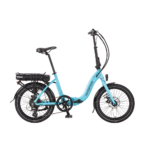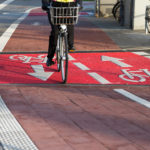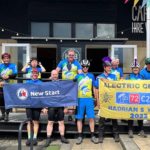Twin motor, 2 wheel drive
- Thread starter Tinker
- Start date
In dynamic terms, better traction on indifferent surfaces is the only advantage. Twin motor drive can also be a disadvantage by impairing stability, though this is less critical with such low powered motors. Attempts to produce twin engined cars have usually failed for this reason, John Cooper of Cooper Cars and Mini-Cooper fame killed himself with his experimental two engined (front and rear) Mini, and BMCs twin engined optional Mini-Moke was a failure. As four wheel drive experience has shown, it's important for stability to have slightly more drive applied at the front than at the rear, particularly for turns, and this is difficult to achieve with two independent motors.
There is a residual advantage of two independent motors though, if one or it's controller fails, the other gets you home.
It's definitely not legal to have two motors summing to more than a 250 watt rating if having them both running at once is under the rider's control.
There is a residual advantage of two independent motors though, if one or it's controller fails, the other gets you home.
It's definitely not legal to have two motors summing to more than a 250 watt rating if having them both running at once is under the rider's control.
If you cant sync the two motors in tandem maybe you could have one running on pedal assist and the other working on throttle only, not sure what advantage that would have except add weight to the system, a bit of a quandary 
ps legality is not the issue, its the technical challenge one should applaud.
ps legality is not the issue, its the technical challenge one should applaud.
Last edited:
John did have a nasty accident in a twini Mini in 1963 on the Surbiton bypass and suffered a bad head injury but recuperated in Worthing Hospital which prompted him to move there and set up a new Garage.John Cooper of Cooper Cars and Mini-Cooper fame killed himself with his experimental two engined (front and rear)
The twini was made up by installing another front sub frame in the rear of the car. A weld to lock the rear steering failed and he ended up cart wheeling down the road.
I know of around 6 twini's being successfully operated around the globe - the biggest problem was to link 2 throttles to give balanced power.
John passed away in 2000 with the big C.
Michael, his son, now sells a line of traditional bicycles called CooperBikes.
Last edited:
But which one? The engineering technical challenge or the legal technical challenge of how to get round the current law?ps legality is not the issue, its the technical challenge one should applaud.
The second could be even more fun!
Thanks Shemozzle, I'd seen a reference some while ago to the death being due to the crash, clearly wrong though.John did have a nasty accident in a twini Mini in 1963 on the Surbiton bypass and suffered a bad head injury but recuperated in Worthing Hospital which prompted him to move there and set up a new Garage.
The twini was made up by installing another front sub frame in the rear of the car. A weld to lock the rear steering failed and he ended up cart wheeling down the road.
I know of around 6 twini's being successfully operated around the globe - the biggest problem was to link 2 throttles to give balanced power.
The technical problem was the one I referred to, the impossibility of getting dependable proportioning of power for the two engines with the front one slightly leading, they shouldn't be equally balanced as high speed FWD has shown. BMC quickly abandoned the FWD version of the Moke for this instability reason.
No problem flecc, just an avid fan of the man and his cars - was told the story from the horses mouth - admired him much - a latter day Cwah
Original Twini article:
Twini Mini
Original Twini article:
Twini Mini
Last edited:
Thanks Shemozzle, I've since remembered where I saw someone post that wrong outcome, it was a computer forum years back, wandering off topic just as we do often!
Nice to see real Minis again, rather than the later variants and the BMW made weirdness.
.
Nice to see real Minis again, rather than the later variants and the BMW made weirdness.
.
Last edited:
flecc said 'As four wheel drive experience has shown, it's important for stability to have slightly more drive applied at the front than at the rear'.
My Escort Cosworth has a 40:60 front:rear permanent 4WD and it was very well regarded for its handling. There's clearly more to it than I thought.
My Escort Cosworth has a 40:60 front:rear permanent 4WD and it was very well regarded for its handling. There's clearly more to it than I thought.
Going back to the legality, if two legal kits were fitted front and rear, presumably used one at a time that would still be legal. What happens when used together with a shared throttle? as I see it the top speed (assisted) dosn't alter.
mind you why you'd do it I still don't understand unless for a non-legal MTB
mind you why you'd do it I still don't understand unless for a non-legal MTB
It is a interesting project. I think having two batteries, and autonomous set up per motor, one running on pas, and the other maybe running on throttle only, could have advantages in distance/mph.Going back to the legality, if two legal kits were fitted front and rear, presumably used one at a time that would still be legal. What happens when used together with a shared throttle? as I see it the top speed (assisted) dosn't alter.
mind you why you'd do it I still don't understand unless for a non-legal MTB
I myself have a FWD bike, so when I pedal, and incorporate power, there are no instability issues., and I wonder why there should be with a powered 2WD running in tandem be different?
Last edited:
It would have to be set up so that it was only possible to use one motor at a time, otherwise the bike would have too much power available to be classified as an electrically assisted pedal cycle (EAPC) so it would be treated as a motorcycle.Going back to the legality, if two legal kits were fitted front and rear, presumably used one at a time that would still be legal.
Again it's the power of the motors that would be the problem, the controls would have to be such that the combined power of the two motors can't exceed the maximum power of one motor, which may limit the advantages somewhat.What happens when used together with a shared throttle? as I see it the top speed (assisted) dosn't alter.
mind you why you'd do it I still don't understand unless for a non-legal MTB
D
Deleted member 4366
Guest
What's legal and what's not has not really been tested in UK law. My Bafang BPM motor has 350w written on it, so some might say that it's illegal. My understanding is that the Emotion Neo series ebikes also have the BPM motor, but ithey have EN 15194 certificates and so do bikes with the Bosch motor which are nearly as powerful. It seems that they're either using the 0 to 20m acceleration test to judge power when certifying or taking power on the say-so of the manufacturer. So, to get your EN15194 certificate, you need a nice slow power ramp in your controller to defeat the acceleration test and a speed limiter. Both these things can be done with a Speedict, which can limit power and speed and can also give slow power ramp, so you can make most bikes legal, but still have power for hill-climbing. The Speedict also has built in legal modes that you can select from a menu to get compliance with various legal standards. None of this has been tested in law and probably won't be until someone is killed. Hopefully that'll never happen.
I thought i had seen this on here in the past http://www.pedelecs.co.uk/forum/electric-bicycles/5970-twin-hub-powertrek-gets-thumbs-up.html
EN15194 labs do claim to be testing the actual continuous motor power, but as you imply d8veh, many that clearly exceed the legal capabilities do get certified.
The prosecution issue is much clearer though, if a motor carries a 350 watt label for example, prosecution under UK law is possible with an absolute certainty of conviction. What makes the certainty is the requirement for all e-bikes to carry a manufacturer's or Vehicle Inspectorate approved permanent plate bearing the certified motor power which must be within legal limits, battery voltage and bike weight. The plate has to be on the bike, not motor, and in a position where it can be easily read. We know that almost all don't comply, but the non-compliance of others is not a valid defence of course.
There is further legal support for a prosecution in the EU order 2002/24/EC which was passed into UK law in 2003, a type approval regulation which clearly specifies that only e-bikes of 250 watts or under continuous power rating and meeting EU pedelec requirements are exempt from type approval as a motor vehicle.
.
The prosecution issue is much clearer though, if a motor carries a 350 watt label for example, prosecution under UK law is possible with an absolute certainty of conviction. What makes the certainty is the requirement for all e-bikes to carry a manufacturer's or Vehicle Inspectorate approved permanent plate bearing the certified motor power which must be within legal limits, battery voltage and bike weight. The plate has to be on the bike, not motor, and in a position where it can be easily read. We know that almost all don't comply, but the non-compliance of others is not a valid defence of course.
There is further legal support for a prosecution in the EU order 2002/24/EC which was passed into UK law in 2003, a type approval regulation which clearly specifies that only e-bikes of 250 watts or under continuous power rating and meeting EU pedelec requirements are exempt from type approval as a motor vehicle.
.
Last edited:
That's good, it just needs the bike's weight added.My bike's got a 250w 36v plate attached, with a "limited to 15.5mph" line for good measure
Related Articles
-
 MTF Enterprises announces acquisition of EMU Electric Bikes
MTF Enterprises announces acquisition of EMU Electric Bikes- Started by: Pedelecs
-
 Wisper 806T folding bike wins Which? ‘Best Buy’
Wisper 806T folding bike wins Which? ‘Best Buy’- Started by: Pedelecs
-
 Sustrans calls for protected cycle lanes
Sustrans calls for protected cycle lanes- Started by: Pedelecs
-
 Amazon launch their first UK e-cargo micromobility hub
Amazon launch their first UK e-cargo micromobility hub- Started by: Pedelecs


